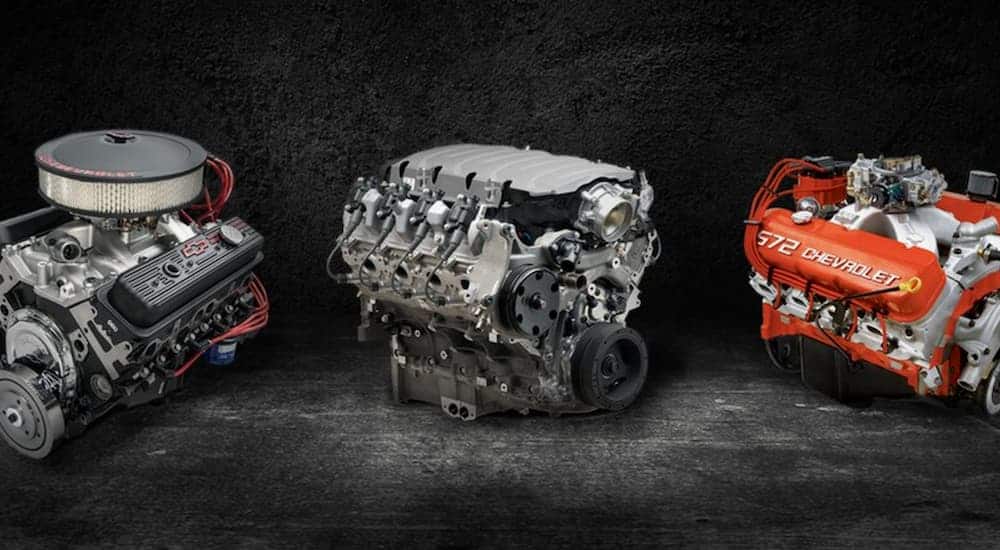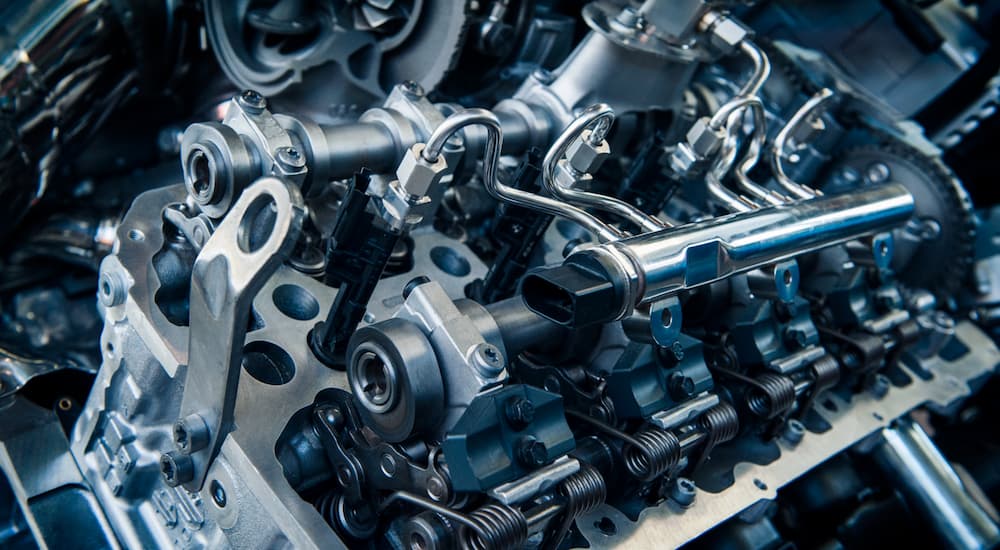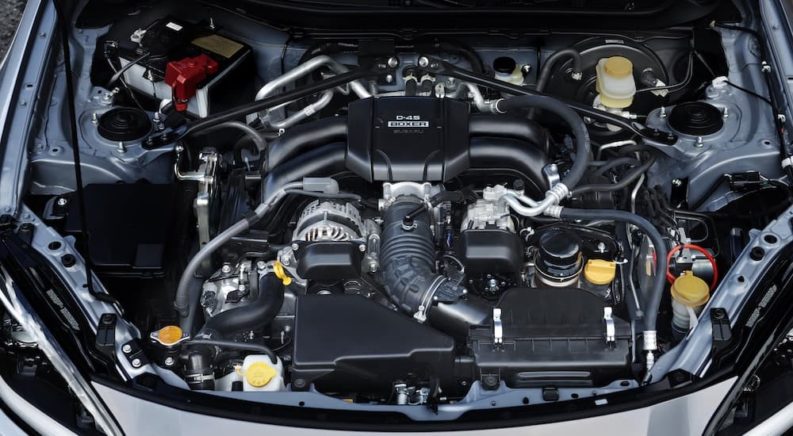If you’ve been around automotive magazines, blogs, and vlogs long enough, you’ve heard about crate engines. But if you’re like me and haven’t spent a lot of time in a garage, you might have questions about what that term means. In my case, the pronoun “Krait” has been subconsciously associated with a spaceship marque in the Elite: Dangerous video game, and though I know nobody in a car video is talking about the Krait Mk II spaceship model, my brain makes the connection anyway.
It makes my head hurt, so I had to take action and learn a thing or two about the real thing. In case you know as much about crate engines as Krait engines, here’s an introduction to the ones that go under your hood.
What Is a Crate Engine?
A crate engine is an aftermarket engine, with an affectionate reference to the typical method of packaging. Cardboard boxes just won’t cut it, because an engine can easily weigh more than 500 lbs. Aftermarket engines are typically shipped in wooden crates, hence, “crate engines.”
That’s where the simplicity ends. Back in the day, when engines were simpler and more people had hands-on machining know-how, mechanical repairs and upgrades were the domain of the owner. Bottom-up builds of custom engines were not at all unheard of. Experiments with some component or another could always blow up in someone’s face, but repairs and adjustments could be readily made.
Nowadays, our collective societal skillsets are different and engines are a lot more complicated. If the industry wants to support enthusiasts, they can’t just count on everyone to develop the skills needed to do their own work. Crate engine manufacturers have taken away the grueling work of creating a piece-by-piece engine blueprint and made it significantly easier to replace a worn-out power plant, make a significant upgrade, or just to tinker with some of the build while trusting that the foundational components are going to work.
That’s great news, but the options are seemingly endless. A crate engine can be brand new, remanufactured or rebuilt. It can be a bare bones block, a turn-key assembly, or anything in between. It can be designed for daily driving to drag racing, can easily cost more than the car you buy it for, and always demands clever solutions to unforeseen problems during the install. There’s a lot to think about, so for starters, let’s address where a crate engine comes from.
Who Makes Crate Engines?
Crate engines are made by a variety of manufacturers whose names may already be familiar to you. Chevrolet Performance has been supporting high-performance Chevys for nearly 60 years. In fact, Chevy Performance takes credit for inventing the idea of the crate engine when their 427 was delivered in factory C3 Corvettes and COPO Camaros, enabling them to offer these engines as aftermarket parts. They’re known for supporting their product with a leading warranty and producing some of the most famous engine lineages in history. Descendants of the original small-block and big-block V8s from the 1950s are still in production, and the more modern LS line has become a meme since it’s cross-compatible with such a wide variety of recipient vehicles.
You’ll also recognize Ford Performance, created by the merger of SVT, SVO, and Ford Racing back in 2014. They’re responsible for the Shelby GT350’s intoxicating flat plane crank VooDoo engine, the GT500’s incredible Predator, and the beloved Coyote V8, available in a crate.
Others may not be so familiar, but the engines they offer sure are, such as ATK Remanufactured’s 2JZGTE. This is the very same 2JZGTE that was capable of making over 1000 hp in modified Mk IV Toyota Supras. Even remanufactured boat engines can be sourced through ATK, who have made a name over 80 years of engine building for producing quality parts, engineering solutions to OEM engine problems, and backing their builds with solid warranties.
I’m only scratching the surface here. HKS, Edelbrock, Blueprint, Mopar, and even Hennessey (so I’ve heard, but couldn’t confirm) produce or restore engines for aftermarket installation. Whether the parent brand’s name speaks for itself, or a habit of producing dependable engines propels their success, there are plenty of reputable sources to supply crate engines.

Why Would You Use a Crate Engine?
Unlike brakes, which cost a couple hundred bucks worth of parts and labor to replace when they wear out, an engine is a big deal. Replacing an engine is the automotive equivalent of a heart transplant. The parts are expensive, the labor is intensive, and there are always complications. So why bother?
The first reason is for the love of the car. Whether it’s the car that taught you stick shifting, a decrepit barn find that’s the same model your grandpa drove, or just the best dang car you’ve ever had, you love that automobile and will not let it go when the engine gives out. Crate engines can cost well under $10,000, like ATK High Performance’s Ford 351W, while the average new car in 2023 costs over $30,000. Swapping a factory-quality engine into a beloved car can be cheaper than rebuilding the engine you’ve already got, and with the huge cost to replace the car outright, a crate engine can be a worthwhile alternative to save your automotive amoré.
The pursuit may also be related to performance. Many classic engines can be acquired as crate products, which is perfect for restoring iconic vehicles to OEM condition. On the other hand, you might care less about OEM legitimacy and more about enjoying regular jaunts in your old-school muscle car. Swapping a modern engine into a classic car can improve driving character, fuel efficiency, and more, without giving up everything else you love about a classic ride. Or, it may just be that whatever vehicle you’ve got, you want more from it, and the straightest line to faster times is often an engine swap.
The last reason, as I see it, overlaps with the others. That reason is passion. Perhaps you don’t care much for 0-60 times or the valuation of “as-stock” condition, and there’s nothing wrong with your vehicle’s current power plant. Except, perhaps that power plant is not a Hellcat. Or perhaps you’ve come into a 1969 Ford Mustang with a Windsor, but you’ve been dreaming about driving a Boss 429 since you were a kid. A crate engine can be just the ticket to make your “impossible” dream car a reality.
These reasons aren’t all strictly rational, and won’t resonate with everybody. Honestly, I’m not sure they resonate with me. All that means is that an engine swap probably isn’t for me, at least not today when I’ve got a family to support, a home to maintain, and a need for practical vehicles. In the same way that buying new (or heavily used) cars isn’t the right choice for everyone, neither is a crate engine, and that’s okay. It’s just important to recognize that before diving in, because boy, the waters are murky.
What Matters When Choosing a Crate Engine?
Options when selecting a crate engine are practically endless, despite all the work that’s gone into curating high-quality builds for you. For starters, consider your own priorities. What matters most to you? Is it minimizing cost, having an easy installation, maximizing power, or providing a specific driving character? The answer will guide you through some of the options.
Chief among these is the degree of newness. Performance-built engines are often brand new, as are many OEM-supplied crates, but depending on what you’re willing to put up with there are far less expensive options available. Old engines can undergo recovery manufacturing to restore original (or superior) performance, with the extent of the efforts made communicated by the label.
- Rebuilt engines will be disassembled, inspected and cleaned. Overworn or broken parts will be replaced to restore acceptable performance.
- Remanufactured engines have all parts replaced or restored to same-as or better than new condition, with well-defined specifications to meet or exceed OEM standards and produce fully warranted engines.
- Reconditioned engines follow a similar recovery practice, but not quite as extensive a restoration to keep the price down.
In addition to decisions about quality, you’ll need to consider the completeness of the build. You may already have your own camshafts, spark plugs, intake manifolds, and more to use with the build, or you may be interested in replacing the entire powertrain. Options fall generally into four categories.
- Short block crates supply only the most basic core components: the block itself, the crankshaft, the pistons, and not much else. These are great for putting together a custom build if you can’t find a perfect pre-designed solution for what you have in mind.
- Long block crates go further, fleshing out the build with cylinder heads, camshafts, and a valvetrain. Consider the physical limitations of your build. An overhead cam engine has vastly different spatial needs than an overhead valve design.
- A Dress or Complete engine refers to a crate with dressings like the intake manifold and oil pan installed.
- Turn-key engines are ready to go out of the box, as close to plug-and-play as engine installs can get. The Mopar Hellcrate can be supplied with an engine so turn-key that it can remotely start the second it’s unpacked.
Your choice of quality depends on balancing cost and reliability. The extent of the build depends on what parts you have that you intend to reuse, whether a turn-key solution is suitable for your specific application, and how much work you’re interested in doing to put it all together.

Crate It Up
Other considerations include brand matching for ease of install, how much power your vehicle is capable of handling, and how the engine will connect to your other drivetrain components. You may need to source a vehicle-specific harness and consider how a modern crate engine will communicate with the car’s computer systems. If you’re shooting for big power, ensure your budget accounts for upgrades to other components which will need to deal with that change. Turn-key or not, no Miata is equipped to handle a Hellcat engine without extreme modifications.
You might be game to take on this project by yourself. With the right tools, resources, and tons of patience and creativity, it can absolutely be done. Whether you do that, bring the job to a reputable shop, or just ask your local machine shop to restore the engine you have, is all up to you. This is your ride, so do it your way. When it comes to crate engines, that’s the whole point.

